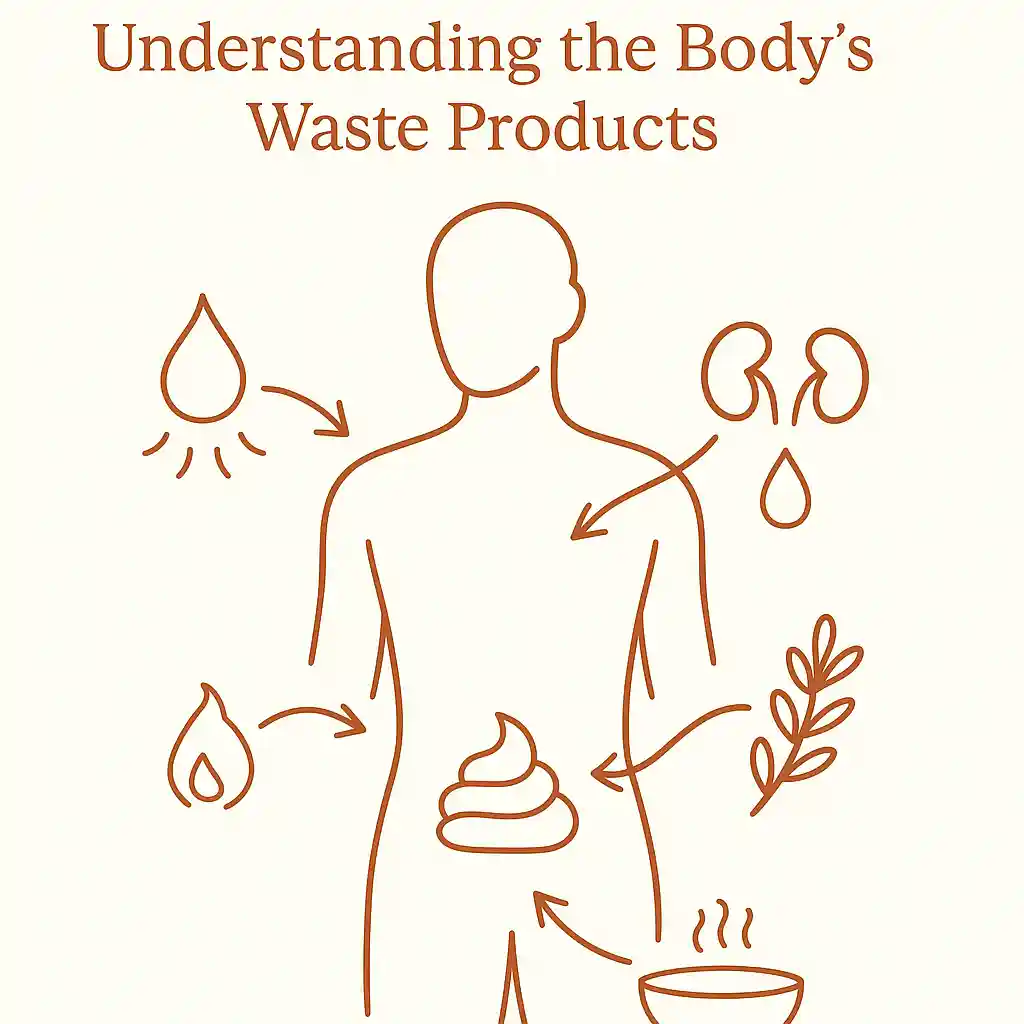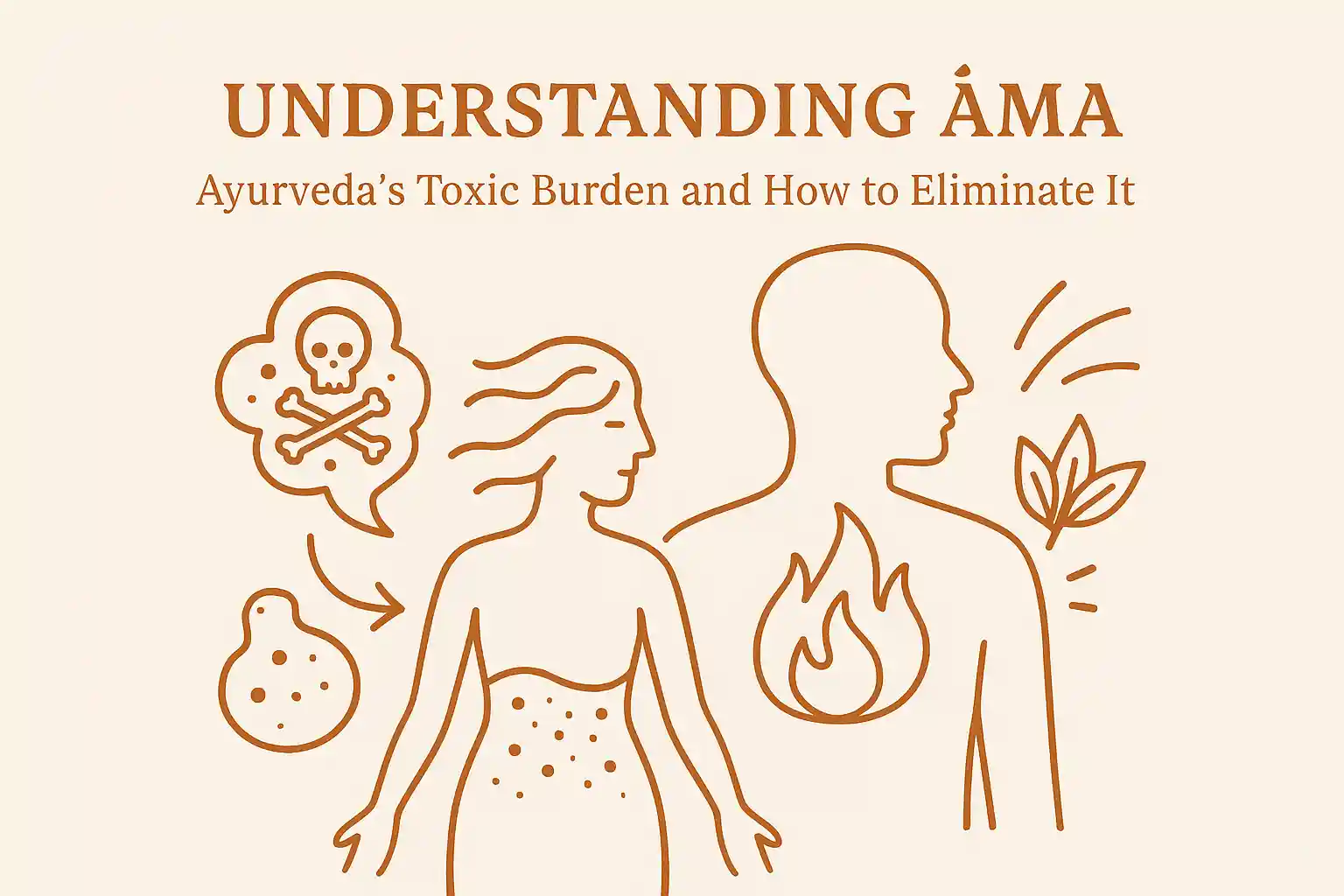
The three Malas - natural waste products that reflect internal balance and health
In Ayurveda, health is not just about what we build (like Dhatus) or maintain (like Agni), but also about what we eliminate. The body must efficiently remove waste to stay in balance. These waste products are known as Mala, and understanding them is essential to grasping Ayurvedic physiology and detoxification.
There are three primary Malas: Purisha (feces), Mutra (urine), and Sveda (sweat). Their proper formation and regular elimination are seen as crucial signs of health. When Mala accumulates or becomes irregular, it can indicate Dosha imbalance, digestive issues, or deeper disease.
What Is Mala in Ayurveda?
The word Mala in Sanskrit means "waste" or "impurity." Ayurveda defines Mala as the natural by-products of digestion and metabolism. Rather than something to be eliminated aggressively, Mala is a normal and vital part of the body's physiological function.
There are three main types of primary Mala:
- 🔸 Purisha (stool/feces)
- 🔸 Mutra (urine)
- 🔸 Sveda (sweat)
Each has its own formation process, site of origin, function, and symptoms of imbalance. Secondary Malas, such as nails, hair, and earwax, are also recognized in classical texts like the Charaka Samhita but are of less diagnostic importance.
The Three Primary Malas at a Glance
| Mala | Site of Formation | Balanced Signs | Imbalance Signs |
|---|---|---|---|
| Purisha | Large intestine (Pakvashaya) | Regular, well-formed bowel movements | Constipation, loose stools, foul odor |
| Mutra | Kidneys and bladder | Pale yellow, odorless, regular urination | Scanty, burning, cloudy, strong odor |
| Sveda | Skin via Meda Dhatu | Light, odorless perspiration with exertion | No sweating, excess sweating, sticky or foul |
Individual Mala Explained
1. Purisha (Feces)
- Formed in the large intestine (Pakvashaya)
- Provides structure and moisture regulation in the colon
- Composed of undigested food, waste fluids, and gut flora residue
Balanced Purisha:
- Regular, well-formed bowel movements
- No straining or urgency
Imbalanced Purisha:
- Constipation (dry or incomplete)
- Loose stools, diarrhea
- Foul odor, mucous, or undigested food particles
Purisha helps remove excess Apana Vata and regulates downward movement. It's especially sensitive to Vata imbalance.
2. Mutra (Urine)
- Formed through the filtration of blood by the kidneys
- Removes excess water, salts, and nitrogenous waste
- Associated with the urinary bladder (Basti) and Apana Vata
Balanced Mutra:
- Pale yellow color
- Mild odor, no pain
- Regular and complete urination
Imbalanced Mutra:
- Scanty, burning, cloudy, or excessive urination
- Strong odor, frequency without quantity
- Linked to Pitta and Kapha imbalances
Mutra plays a critical role in regulating fluid balance and maintaining internal temperature.
3. Sveda (Sweat)
- Formed as a by-product of Meda Dhatu (fat tissue)
- Eliminated through the skin
- Helps regulate body temperature and moisture
Balanced Sveda:
- Light, moderate perspiration during exertion or heat
- Odorless or mild natural scent
Imbalanced Sveda:
- Excess sweating (hyperhidrosis)
- No sweating (anhidrosis)
- Foul-smelling or sticky sweat
Sveda reflects the health of both Pitta Dosha and Meda Dhatu. Heat intolerance and poor skin health may signal Sveda imbalance.
Mala and the Doshas
Each Dosha is associated with the formation and elimination of certain Malas:
- Vata: Governs the expulsion of Purisha and controls peristalsis
- Pitta: Linked to Mutra through metabolic heat and liver function
- Kapha: Influences Sveda via moisture and Meda Dhatu
When Doshas are aggravated, Mala production and elimination are the first systems to be disrupted.
Mala and Agni: The Elimination Link
Just as Agni governs digestion and tissue formation, it also governs the breakdown and excretion of waste. Poor Agni leads to Ama (toxic buildup), which disrupts normal Mala formation and elimination.
Think of it this way: Mala is compost—useful and necessary waste. Ama is sludge—unprocessed, toxic gunk.
Signs of Ama include:
- Sticky or foul-smelling stools
- Cloudy urine
- Heavy, sticky, or odorous sweat
Strengthening Agni is the first step in correcting Mala imbalances.
Seasonal Influence on Mala
Seasonal changes impact elimination:
- Summer: Increased sweating (Sveda); stay cool and hydrated
- Fall: Dryness increases Vata; constipation (Purisha) is common
- Spring: Kapha dominance may lead to sluggish Sveda and Mutra
Aligning your routine with seasonal cycles helps maintain healthy Mala flow.
Supporting Healthy Mala Elimination
Balanced elimination is a daily marker of good health. Ayurveda emphasizes gentle, consistent support for waste removal.
Tips to regulate Mala:
- Eat at regular times to support Apana Vata
- Hydrate with warm water and herbal teas (cumin, coriander, fennel)
- Use ghee or Triphala to ease constipation
- Engage in regular movement, especially early morning walks
- Practice sweating gently through exercise or mild sauna
- Avoid suppressing natural urges like urination, defecation, or sweating
These routines help maintain rhythm, support Dosha balance, and prevent Ama formation.
Final Thoughts
Mala may be waste, but it's far from irrelevant in Ayurveda. In fact, the body's ability to eliminate efficiently is a reflection of overall health. Just as we nourish the Dhatus and protect Ojas, we must also respect the body's intelligence in removing what it no longer needs.
Observing and supporting your elimination patterns is one of the simplest ways to monitor your internal balance.
Sources & Further Reading
Classical Texts
Research & Education
FAQs: Mala in Ayurveda
Related Articles

Introduction to Panchakarma: Holistic Detox Backed by Tradition and Science
Discover Panchakarma, Ayurveda's most profound detoxification system. Learn how this ancient "five actions" therapy removes deep toxins, restores balance, and rejuvenates mind and body through scientifically-backed protocols.
18 min read
Understanding Ama: Ayurveda's Toxic Burden and How to Eliminate It
Discover Ama, the root cause of disease in Ayurveda. Learn how this toxic burden forms from weak digestion and explore safe, natural methods to eliminate it through dietary changes and detoxification practices.
9 min read